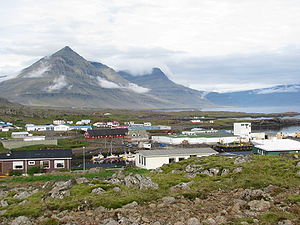Búlandstindur
| Búlandstindur | ||
|---|---|---|
|
Behind the village of Djúpivogur |
||
| height | 1069 m | |
| location | Eastern Iceland | |
| Coordinates | 64 ° 41 ′ 45 ″ N , 14 ° 25 ′ 24 ″ W | |
|
|
||
| rock | basalt | |
|
From Djúpivogur seen from |
||
|
seen from the east side of the fjord |
||
The Búlandstindur is a mountain in East Iceland with a height of 1069 m. It stands on the west bank of the Berufjörður fjord and is easily visible from Djúpivogur .
Origin of the mountain
What is striking about the mountain is its pyramid shape . It clearly consists of almost horizontal layers of different thicknesses.
The mountain consists mainly of basalt layers. In between, several layers of sediment made of sand, clay and earth have pushed themselves in, partly interspersed with remains of vegetation (layers of charcoal).
The basalt layers are about 6 to 7 million years old and come from two different central volcanoes, the lower from the Álftafjörður volcano, which was located south of Búlandstindur, the upper from the Breiðdals volcano . This was in the northwest of the mountain.
About three million years ago when the glaciers of the Ice Age rested on Iceland, ranged glaciers in the cold periods down to the sea and filled the valleys of today's fjords Álftafjörður and Berufjörður out. The mountain protruded from these glaciers as a nunatak . In addition, smaller valley glaciers scraped behind him, so that the glacier erosion affected him from all sides. The landscape of that time can be imagined as something like that in East Greenland.
Goðaþrep
At a height of about 600 m you can see a clearly wide step on the Búlandstindur. This is called Goðaþrep , the stage of the gods, or Goðaborg , the rock of the gods. It is said that, similar to the Goðafoss , the waterfall in the north of the country, the old images of gods were thrown down here after Christianization in the year 1000.
See also
- Austfirðir
- History of Iceland
- Volcanoes in Iceland
- Geography of Iceland
- List of mountains and elevations in Iceland



